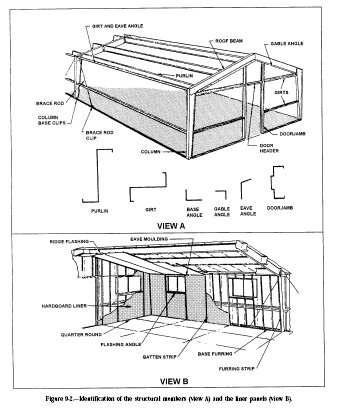 CONSTRUCTION KNOWLEDGE >>
SPECIAL CONSTRUCTION >>
CONSTRUCTION KNOWLEDGE >>
SPECIAL CONSTRUCTION >>
SPECIAL CONSTRUCTION
1. What is Available for Sound and Vibration Controls?
2. What is Available for Radiation Protection?
3. What is Available for Lightning Protection?
4. What Should I Know about Pre-Engineered Building Systems?
5. What Should I Know about Swimming Pools?
6. What Public Domain Documents are Available for Further Study?
7. Tricks of the Trade & Rules of Thumb for Special
Construction:
What is Available for Sound and Vibration Controls?
The special construction in these areas varies widely. Some websites
may prove helpful, though.
Empire
Acoustical Systems provides some useful products to consider, as
does
Industrial Noise Control,
Industrial Acoustics Company
and
Kinetics
Noise Control
X-Rays and CAT scans require radiation shielding, which typically
gets designed by a physicist. The following sites provide information on
the products available and details of construction.
Radiation Protective Products,
Ray-Bar and
A&L Shielding
are manufacture products for radiation protection. Lighting protection systems information can be found at the
East Coast Lightning Equipment
website.
I've helped build many pre-engineered buildings (often called metal
building systems) over the years, from warehouses to air plane hangers
to recreation centers. I like the efficiency of the pre-engineered
systems, but have learned several lessons the hard way. To begin, let's
define a pre-engineered building. If it's a steel frame building and the
steel columns and beams get designed by the building manufacturer, such
as
Butler
Manufacturing,
American
Buildings,
Ceco Building Systems, or
Metallic
Buildings, then it's a pre-engineered building. On the other hand,
if a consulting structural engineer designs the steel beams and columns,
using rolled steel
sections, then it's a conventional steel building. The sketch below from the Navy Builder's Training Manual shows a
simple illustration of a pre-engineered steel building. Pre-engineered buildings can be built for lower cost because of the
system approach: For the Construction Supervisor, one of the advantages of
pre-engineered systems can also be a big problem. Since the structural
design is so efficient, the capacity for the beams and columns to carry
extra loads is minimal. In a conventional steel building, a rooftop unit
or a monorail crane gets added and the extra capacity in the steel
design usually covers the extra load. You need to be much more careful
with pre-engineered building changes. Don't assume any added structural
load will be acceptable. Make sure the pre-engineered building
manufacturer knows about the proposed changes and approves them. Along that same line of thinking, the Construction Supervisor should
know the design loading used on a pre-engineered building. A knowledge
of
basic structural design helps prevent big and small problems. I also
recommend a review of the selected building manufacturer's website. It
helps you get familiar with their products and procedures. The steel purlins that get used on the roof and the steel girts that
get used on the walls are made from cold formed steel framing (different
from the hot
rolled structural steel). The cold forming process passes steel sheets between large rollers to deform the
steel, but at a lower temperature than hot rolling. The rolling process compresses and
stretches the steel, hardening it in the process. Most cold rolled steel
is either 33,000 psi or 50,000 psi yield strength. The sizes and attributes for girts and purlins are shown at
http://www.loseke.com/lgsi.html (which has all the technical
information available about cold formed steel framing). At the site
listed above, you can scroll down the left menu to find the properties
of C sections and Z sections. My general caution for Construction Supervisors working on
pre-engineered buildings: understand that the cost efficiency comes with
a cost. The pre-engineered buildings have less tolerance for changes or
errors than conventional buildings. For example, the water-tightness of
the building often has only one level of protection, if those details
aren't completed correctly, leaks occur. Conventional construction often
provides flashings and counter flashings that catch water that leaks
past a first layer. So you must understand how the pre-engineered system
is designed to work and pay attention that it gets installed correctly. Swimming pool contractors generally handle the hydraulic design, flow
rates, pumps, filters, and chemical management systems. They also know
what they need for excavation, concrete, rebar and grounding. So, while
I've had a few pools built on projects I've been doing, I haven't ever
really learned that much about swimming pool construction. This website shows
how pools are built. Of course, the goal is to build pools that stay
clean and sanitized. No information available at this time.
What is Available for Radiation Protection?
What is Available for Lightning Protection?
What Should I Know about Pre-Engineered Building
Systems?

What Should I Know about Swimming Pools?
What Public Domain Documents are Available for
Further Study?
Tricks of the Trade & Rules of Thumb for
Special Construction Basics:

